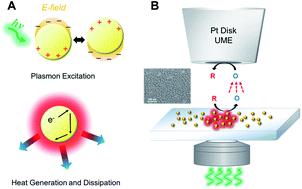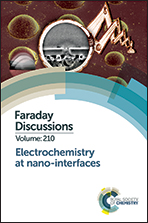Quantifying photothermal heating at plasmonic nanoparticles by scanning electrochemical microscopy†
Abstract
Photothermal heating at metal nanoparticles results from the non-radiative decay of localized surface plasmons. The local heat generation enhances the mass transport rate of redox molecules and causes a shift in their formal potential, both of which can impact an electrochemical process at the nanoparticle interface. Here we present a methodology for probing the surface temperature at a plasmonic nanoparticle substrate using scanning electrochemical microscopy (SECM). Light is used to excite a plasmonic substrate electrode, while an ultramicroelectrode tip is positioned close to the substrate to read out both the mass transfer rate and concentration profile of the redox molecules. The measured mass transfer rate and the shift in the equilibrium potential provide a quantitative value of the temperature increase at the substrate surface, which is verified by simulations using a mass transfer model coupled with heat dissipation. The developed SECM approach is suitable for probing heat generation at a variety of both plasmonic and non-plasmonic nanostructures.

- This article is part of the themed collection: Electrochemistry at nano-interfaces


 Please wait while we load your content...
Please wait while we load your content...